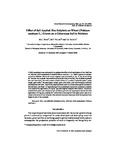Effect of soil applied zinc sulphate on wheat (<i>Triticum aestivum</i>L.) grown on a calcareous soil in Pakistan
| dc.contributor.author | Khan, M | |
| dc.contributor.author | Fuller, MP | |
| dc.contributor.author | Baloch, F | |
| dc.date.accessioned | 2013-02-24T14:03:01Z | |
| dc.date.available | 2013-02-24T14:03:01Z | |
| dc.date.issued | 2008-12 | |
| dc.identifier.issn | 0133-3720 | |
| dc.identifier.issn | 1788-9170 | |
| dc.identifier.uri | http://hdl.handle.net/10026.1/1429 | |
| dc.description.abstract |
A field experiment was conducted to investigate the effect of soil application of zinc fertilizer on yield and yield components of wheat (Triticum aestivum L. cv. Inqlab 91) grown on calcareous soil in Pakistan. The levels of zinc sulphate were 0 (control), 5, 10, 15, 20, 25 and 30 kg ha-2 and the zinc sulphate was combine-drilled at the time of sowing. Zinc sulphate increased the Leaf Area Index, the total number of fertile tillers m -2, number of spikelets spike-2, spike length, grain spike-2, thousand grain weight, grain yield, straw yield and biological yield and decreased harvest index. Most of the response trends were curvilinear although the decrease in harvest index was linear. All applications of zinc sulphate gave economic increases in margins over costs but the application of 5 kg ha-2 gave the highest marginal rate of return. It is recommended that under such calcareous soil conditions growers can expect good returns from the application of 5 kg zinc sulphate ha-2 at the time of sowing but if the grain price were to increase or the price of zinc sulphate were reduced economic responses could be expected from higher levels of zinc sulphate. © 2008 Akadémiai Kiadó. | |
| dc.format.extent | 571-582 | |
| dc.language | en | |
| dc.language.iso | en | |
| dc.publisher | Springer Science and Business Media LLC | |
| dc.subject | zinc | |
| dc.subject | zinc-deficient calcareous soils | |
| dc.subject | yield and yield components | |
| dc.subject | Triticum aestivum L | |
| dc.title | Effect of soil applied zinc sulphate on wheat (<i>Triticum aestivum</i>L.) grown on a calcareous soil in Pakistan | |
| dc.type | journal-article | |
| dc.type | Journal Article | |
| plymouth.author-url | https://www.webofscience.com/api/gateway?GWVersion=2&SrcApp=PARTNER_APP&SrcAuth=LinksAMR&KeyUT=WOS:000261075500006&DestLinkType=FullRecord&DestApp=ALL_WOS&UsrCustomerID=11bb513d99f797142bcfeffcc58ea008 | |
| plymouth.issue | 4 | |
| plymouth.volume | 36 | |
| plymouth.publication-status | Published | |
| plymouth.journal | Cereal Research Communications | |
| dc.identifier.doi | 10.1556/crc.36.2008.4.6 | |
| plymouth.organisational-group | /Plymouth | |
| plymouth.organisational-group | /Plymouth/Faculty of Science and Engineering | |
| plymouth.organisational-group | /Plymouth/Faculty of Science and Engineering/School of Biological and Marine Sciences | |
| plymouth.organisational-group | /Plymouth/REF 2021 Researchers by UoA | |
| plymouth.organisational-group | /Plymouth/REF 2021 Researchers by UoA/UoA06 Agriculture, Veterinary and Food Science | |
| plymouth.organisational-group | /Plymouth/Users by role | |
| plymouth.organisational-group | /Plymouth/Users by role/Academics | |
| dc.identifier.eissn | 1788-9170 | |
| dc.rights.embargoperiod | Not known | |
| rioxxterms.versionofrecord | 10.1556/crc.36.2008.4.6 | |
| rioxxterms.licenseref.uri | http://www.rioxx.net/licenses/all-rights-reserved | |
| rioxxterms.type | Journal Article/Review |


